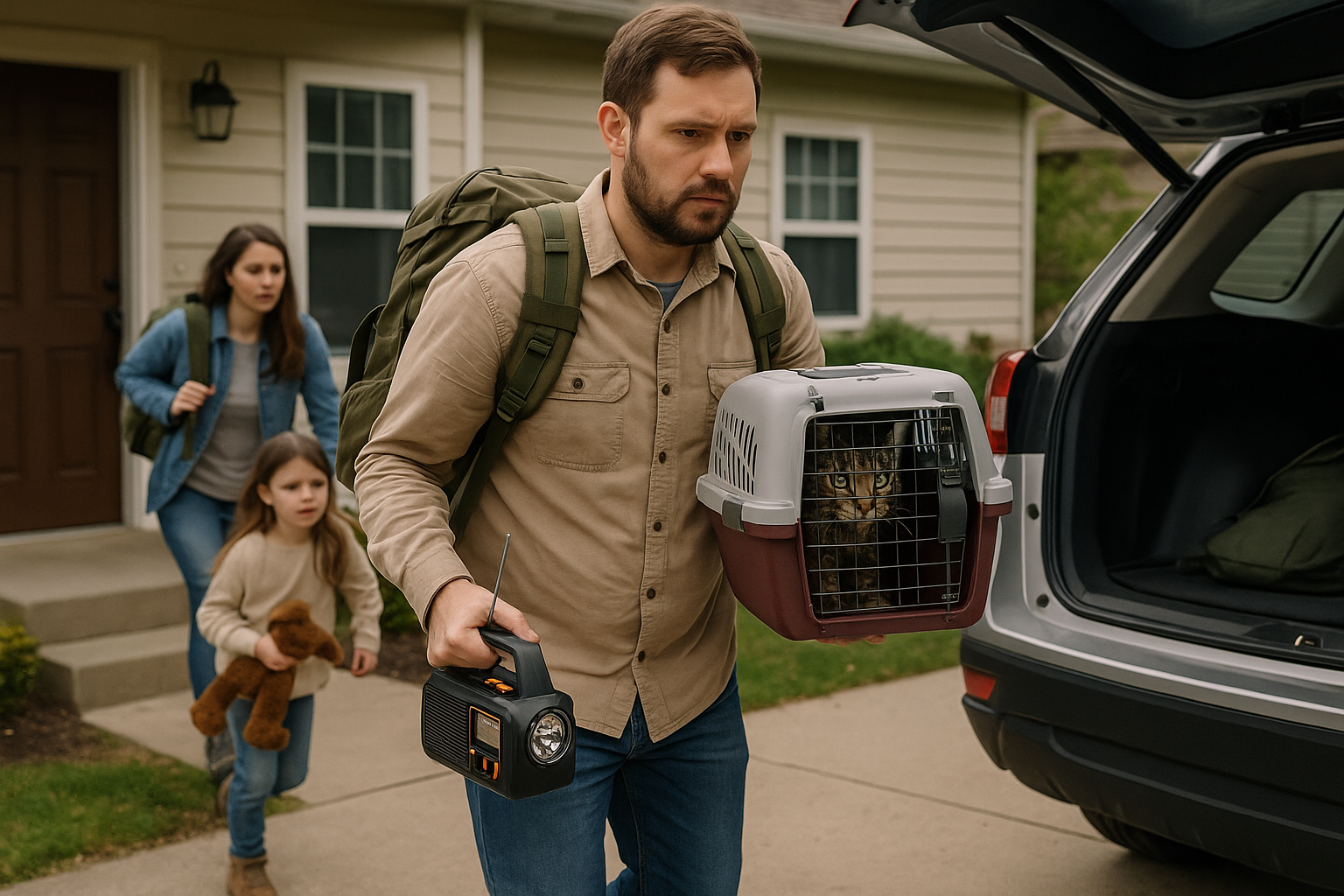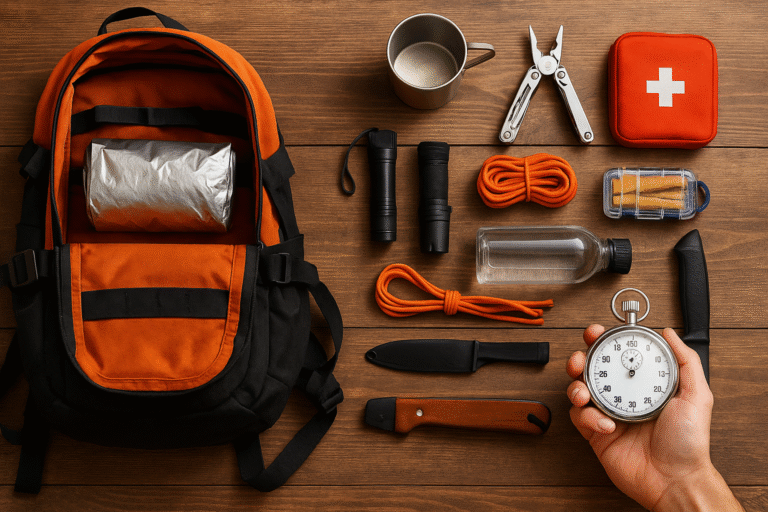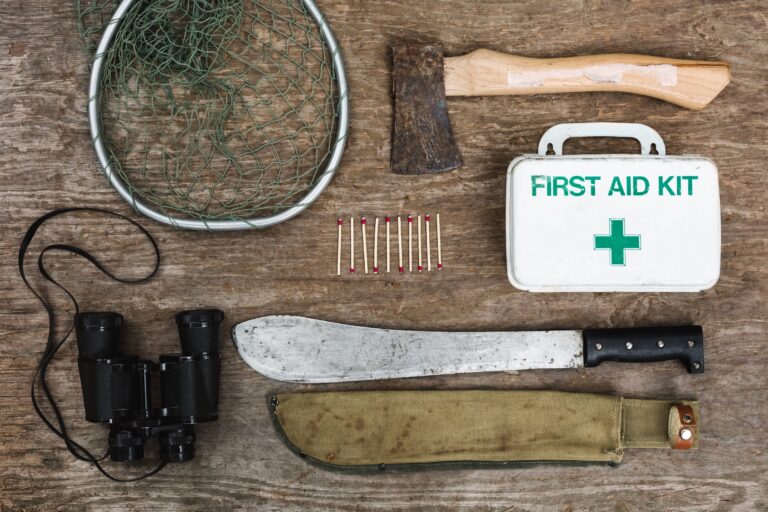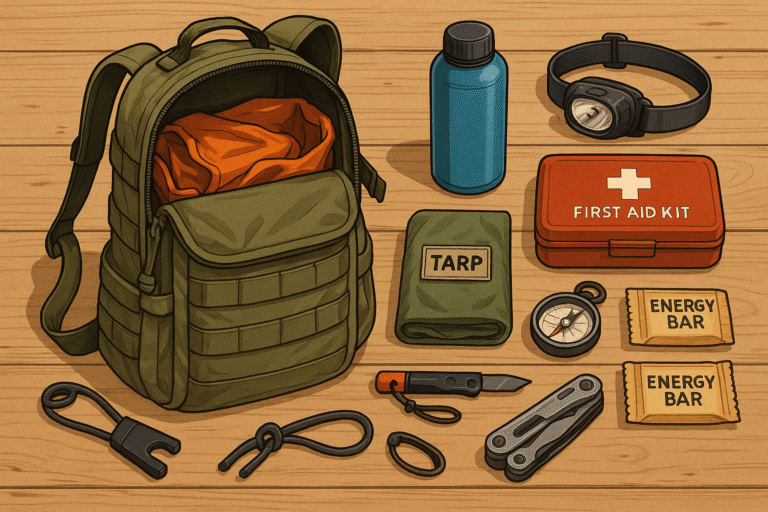Top 10 Mistakes People Make in an Emergency Evacuation (And How to Avoid Them)
This post contains affiliate links. I may earn a small commission at no extra cost to you. Learn more.
Emergency evacuation mistakes are the kind of errors you don’t realize you’ve made until it’s too late — and in a crisis, they can cost you valuable time, resources, and even your life. Whether you’re fleeing a wildfire that’s moving faster than the news can report, escaping a hurricane before roads flood, or leaving town ahead of a chemical spill or civil unrest, the smallest misstep can throw your entire plan into chaos. From hesitating too long to leave, to forgetting essential gear, to taking the wrong route when GPS fails, these mistakes are both common and avoidable. In this guide, we’ll break down the top 10 most dangerous emergency evacuation mistakes, show you exactly how to avoid them, and recommend the gear and strategies that can make the difference between a smooth escape and a life-threatening disaster.
🚀 Quick Emergency Evacuation Mistakes Checklist
(Screenshot this for reference — it could save your life.)
-
Waiting too long to leave
-
Leaving without a go-bag
-
No pre-set evacuation route
-
Overpacking or underpacking
-
Ignoring vehicle readiness
-
Not communicating your plan
-
Forgetting about pets
-
Not dressing for conditions
-
Forgetting critical documents
-
Underestimating mental stress
1️⃣ Waiting Too Long to Leave
🚨 The Mistake:
Hesitating in the face of danger. This happens because:
-
People underestimate how fast threats like wildfires or flash floods move.
-
They wait for “mandatory” orders instead of acting on early warnings.
-
They waste time gathering non-essential items.
Real-World Example:
In the 2018 Camp Fire (Paradise, CA), dozens were trapped because they delayed just 20–30 minutes after noticing smoke. By then, flames and gridlock made escape impossible.
✅ The Fix:
-
Set trigger points (“If fire crosses Hwy 21, we go.”) so there’s no debate.
-
Trust early signs — if police, neighbors, or emergency scanners warn of danger, act now.
-
Practice a 5-minute departure drill with your household.
-
Keep essentials already staged (go-bag, important documents, pet carrier).
Gear Tip: NOAA emergency weather radio — gets alerts when cell towers are down.
🔗 Related Reading: Wildfire Evacuation Planning: Summer Readiness Checklist
2️⃣ Leaving Without a Go-Bag
🚨 The Mistake:
Leaving with just your phone and wallet. You’ll quickly run into problems like:
-
No food or water.
-
No first aid if injured.
-
No tools for shelter, navigation, or hygiene.
Real-World Example:
After Hurricane Katrina, many evacuees arrived at shelters without even basic hygiene items, leading to preventable illness and discomfort.
✅ The Fix:
-
Build a go-bag now for each family member.
-
Include food, water, first aid, weather protection, light source, and navigation tools.
-
Rotate perishables every 6 months.
Gear Tip: EVERLIT 72-Hour Survival Backpack — pre-packed and ready to grab.
🔗 Related Reading: Top 15 Survival Tools You’ll Regret Not Packing in an Emergency
3️⃣ No Pre-Set Evacuation Route
🚨 The Mistake:
Relying on GPS or “figuring it out later.” Risks include:
-
Dead cell towers.
-
Road closures or gridlock.
-
Dangerous detours.
Real-World Example:
During the 2020 Oregon wildfires, evacuees who depended on GPS were sent toward fire zones because maps weren’t updated fast enough.
✅ The Fix:
-
Have two primary and one backup route from home and work.
-
Keep paper maps in your car and go-bag.
-
Pre-mark gas stations, safe stops, and alternate meeting points.
Gear Tip: National Geographic Road Atlas — reliable and durable.
🔗 ASPCA – Disaster Preparedness for Pets
4️⃣ Overpacking (Or Underpacking)
🚨 The Mistake:
Overstuffing your vehicle delays departure. Underpacking leaves you without basics.
Real-World Example:
After the 2011 Japan earthquake, some evacuees brought so much gear they couldn’t transport all family members, while others left with almost nothing and suffered for days.
✅ The Fix:
-
Pack only life-sustaining essentials: food, water, clothing, tools, documents.
-
Keep non-essentials stored at home, not in your vehicle.
-
Practice loading your vehicle with only evacuation gear.
Gear Tip: Rite in the Rain checklist notebook — ensures nothing vital gets missed.
5️⃣ Ignoring Vehicle Readiness
🚨 The Mistake:
Trying to evacuate in a vehicle with:
-
Low fuel.
-
Bald tires.
-
Dead battery.
Real-World Example:
During Hurricane Rita, many evacuees broke down on highways due to poor vehicle prep, stranding families in extreme heat for hours.
✅ The Fix:
-
Keep your gas tank at least half full year-round.
-
Store a jump starter, tire repair kit, and spare in your vehicle.
-
Check tire pressure and oil regularly.
Gear Tip: Noco Boost Jump Starter — doubles as a power bank.
6️⃣ Not Communicating Your Plan
🚨 The Mistake:
Leaving without telling anyone your route or destination. Risks include:
-
No one knowing where to look if you go missing.
-
Delayed reunification with family/friends.
Real-World Example:
During the 2017 California floods, families were separated for days because no meeting points were set.
✅ The Fix:
-
Share your plan with two trusted contacts.
-
Set check-in times via text, email, or satellite communicator.
-
Designate a primary and backup meeting point.
Gear Tip: Garmin inReach Mini 2 — GPS text messaging without cell service.
7️⃣ Forgetting About Pets
🚨 The Mistake:
Evacuating without pet supplies or leaving pets behind.
Real-World Example:
After Hurricane Harvey, over 100,000 pets were displaced — many because owners didn’t have carriers or food ready.
✅ The Fix:
-
Prepare a pet go-bag with food, water, meds, and ID tags.
-
Practice loading pets calmly before emergencies.
-
Know which shelters/hotels accept animals.
Gear Tip: Portable pet water bottles — lightweight and space-saving.
8️⃣ Not Dressing for Conditions
🚨 The Mistake:
Leaving in flip-flops or light clothing in bad weather.
Real-World Example:
Winter storm evacuees in Texas (2021) suffered frostbite because they didn’t bring cold-weather gear.
✅ The Fix:
-
Keep weather-appropriate clothing in your vehicle year-round.
-
Include sturdy boots, rain jackets, gloves, and thermal layers.
Gear Tip: Merrell Moab 3 Tactical Shoes — rugged and waterproof.
9️⃣ Forgetting Critical Documents
🚨 The Mistake:
Leaving without ID, insurance papers, or medical records.
Real-World Example:
After the 2010 Haiti earthquake, displaced people without IDs faced weeks of delays getting aid.
✅ The Fix:
-
Store documents in a waterproof, fireproof pouch.
-
Keep encrypted USB backups in your go-bag.
-
Have printed copies of emergency contacts.
Gear Tip: SentrySafe Fire/Water Bag — compact and secure.
🔟 Underestimating Mental Stress
🚨 The Mistake:
Panic leading to poor decision-making and accidents.
Real-World Example:
During the 2004 Indian Ocean tsunami, many fled in the wrong direction due to panic and misinformation.
✅ The Fix:
-
Practice evacuation drills until actions are automatic.
-
Carry small comfort items for children to reduce fear.
-
Focus on controlled breathing and clear communication.
Gear Tip: A compact deck of cards can help calm stress during downtime.
📦 Evacuation Gear List (Quick Access)
📝 FAQ – Emergency Evacuation
Q: How much time should you plan for evacuation?
A: In some cases, less than 15 minutes. Your goal is to be on the road in 5 minutes or less.
Q: What should be in a pet evacuation kit?
A: Food, water, meds, carrier, leash, waste bags, vaccination records.
Q: How do you evacuate without a car?
A: Arrange rides in advance, keep lightweight gear, and know public transit emergency routes.
Final Takeaway
Avoiding emergency evacuation mistakes isn’t just about being prepared — it’s about protecting your life, your loved ones, and your ability to recover quickly after disaster strikes. The difference between a smooth, controlled evacuation and a dangerous scramble often comes down to preparation, communication, and having the right gear on hand. Start building your plan now, practice it regularly, and make sure every family member knows exactly what to do when the time comes. The more you rehearse and refine your strategy, the less likely you are to make the same critical errors that catch so many people off guard.
📌 Next Step:
Read our DIY Bug-Out Bag Guide and start assembling your essentials today — before you ever have to put them to the test.







